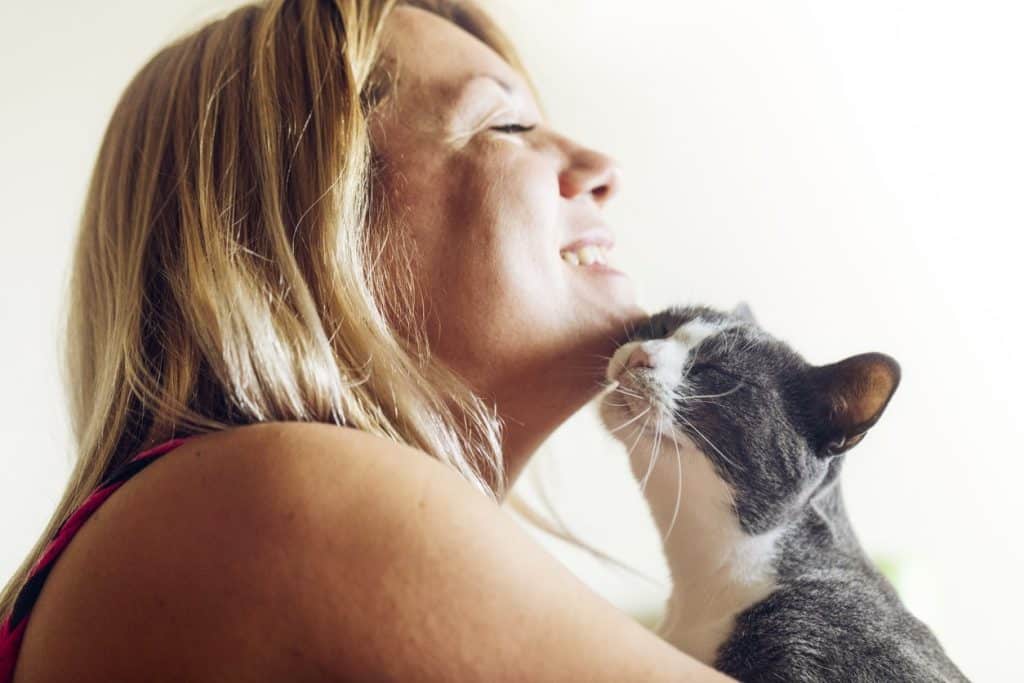If you’ve ever befriended a picky (and maybe prickly) kitty, you know how special it feels to be their favorite person. Some of this is biological. 12,000 years ago, our cats’ wild ancestors domesticated themselves when they learned that people were an excellent source of food and shelter. Relying on humans to meet their basic needs relates to how, today, domesticated cats often choose to bond with one person. If you’ve ever wondered how and why cats have a favorite person, the short answer is cats loving and choosing a favorite human caregiver stems from a combination of personality, human-cat communication, routine, and environment.
Below, learn the surefire signs you’re a cat’s favorite and how to better your bond with them in the long run.
7 Signs You’re Your Cat’s Favorite Person
Beyond the most obvious and universal displays of feline happiness and contentment, like purring and kneading, there are some other subtle and unmistakable signs you’re your cat’s favorite person.
Molly DeVoss, a Certified Feline Training and Behavior Specialist and founder of Cat Behavior Solutions, says these signs include the following.
- Head bunting. When your cat bonks their forehead against your hand, arm, legs, or body part closest to them, they want to feel close.
- Scent marking. Cats have scent glands all over their body. When they rub their cheeks, paws, or tails against you, it creates a shared scent profile, strengthening your bond.
- Allogrooming. When your cat tries to lick or “groom” your hair, it’s your cat’s way of showing they consider you part of their family!
- Rubbing teeth. Some cats like to mark you with their unique scent by rubbing their mouth, teeth, and the saliva on them against you.
- Bringing you their toys. Cats often carry their toys to their favorite person when they want to engage them in interactive play.
- Rolling around. When cats expose their vulnerable stomachs to us and roll around flashing their bellies, they communicate deep trust.
- Being near you. Following you around the house and sleeping next to you on the couch are some ways cats show they love you.
Why Does My Cat Prefer Someone Else?
Anyone with multiple cats knows every cat is unique. However, DeVoss says cats generally gravitate toward people who feed them, play with them, give them tasty treats, and keep their litter box clean.
Additionally, she says cats prefer when you have a calming presence, consistent patterns, and predictable movements and exhibit cat-friendly, welcoming body language.
Lastly, DeVoss says trauma also shapes a cat’s ability to attach to specific people. If a cat (or kitten) was in an abusive or neglectful situation with a certain demographic, they’re more likely to feel uncomfortable and unsafe around some types of people.

iStock/IvanJekic
How To Become Your Cat’s Favorite Person in 5 Easy Steps
If you just adopted a cat, are trying to win over a new roommate’s or partner’s kitty, or looking to deepen your bond with your current cat, here are five strategies DeVoss recommends.
1. Bond early
DeVoss says there’s a critical window in a kitten’s early social development. The first three to seven weeks of their life play a significant role in how kittens respond to people. Regular handling and exposure to different sounds and smells can help kittens grow into well-adjusted, human-bonded cats.
However, kittens without any human interaction during that period will be more guarded, suspicious of other people, or even fearful. DeVoss says anything a cat didn’t experience during that development window in their kittenhood will take time to learn they can trust it.
2. Establish cat-friendly communication
The best cat-human relationships happen when you communicate with your kitty in a way they like. Importantly, that communication style doesn’t always include an invitation to pet them.
One communication style cats love is eye contact. In a cat’s world, slow blinking communicates safety and is non-threatening, while staring is a challenging gesture. Acknowledging their presence, like saying hello and making appropriate cat-friendly eye contact, lets your cat know you see and appreciate them.
Another form of communication frequently favored by cats includes respecting their personal space. Cats prefer to feel in control. Allow your cat to come to you and initiate interactions, and don’t forcibly touch or pet them in places they dislike.
3. Set boundaries
When cats are uncomfortable with a situation, DeVoss says they prefer to leave rather than confront it. This is why cats uncomfortable with strangers usually hide when visitors are over.
DeVoss says one of the best ways to respect your cat’s boundaries and become their preferred person is to understand and honor their uncomfortable zones. This means keeping your hands off their “no petting places,” like their bellies, legs, and paws, and over their heads.
Lastly, don’t interact with cats while they’re sleeping or force them to do something they don’t want to.
If you’ve violated their boundaries, DeVoss says cats will often react by recoiling, hiding, swatting, biting, scratching, or hissing.
4. Prioritize quality time
Playtime requires attention and exercise from your cat. This, in turn, creates feel-good hormones and boosts the connection between you two.
DeVoss says playing and enrichment gives cats an outlet for their natural behaviors, such as hunting, climbing, scratching, and foraging. Allowing cats to satisfy these primal needs only deepens their love for you.
Perch spots, cardboard boxes, scratching posts, paper bags, cat grass, wand toys, lick mats, and puzzle toys are just some of the items you can keep around the house to help them meet these needs.
If your cat enjoys physical touch, DeVoss says to mindfully pet or scratch them in their favorite areas, such as around their ears, chin, and cheeks. Keep petting sessions short and be aware of your cat’s body language, like if they lean into your hand, to see if they want more or had enough. Lastly, only pick them up if they ask for it (and always do it correctly!)
5. Keep a regular schedule
Cats are creatures of habit. Literally. Keeping a regular schedule is one of the simplest ways to help you bond with your cat and become their favorite person.
DeVoss says an established feeding schedule can help your cat build trust. It’s natural for cats to eat small meals scattered throughout the day, and if possible, she says pet parents should feed their cat four or five times a day.
Dividing who dishes out breakfast and dinner for a cat is one of the easiest ways for multiple people to develop equally loving and trusting relationships with them.

iStock/SetsukoN
It Takes Time To Become The Favorite
It’s natural to want to be your cat’s favorite person right off the bat, but sometimes that’s not possible. With cats, trust and love are not guaranteed right away; instead, the relationship needs careful but worthwhile nurturing.
If you take meaningful steps to develop a trusting, loving relationship, you’ll become your cat’s favorite person in no time.


